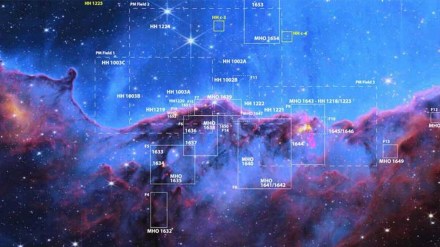Astronomers studied the first images taken by the National Aeronautics and Space Administration’s James Webb Space Telescope (JWST) and found tell-tale signs of twenty four stars that are around 7,500 light years away from the Earth and were earlier unseen.
According to the the research published in the Monthly Notices of the Royal Astronomical Society, scientists investigated Webb’s NIRCam (Near-Infrared Camera instrument) data of the “Cosmic Cliffs,” a star-forming region, which is known as NGC 3324 in the Carina Nebula, reported The Indian Express. With the help of the instrument, astronomers get enabled to look through clouds of interstellar dust.
“Webb provides the researchers a snapshot to see how much star formation has happened and what may be a more typical corner of the universe that we haven’t been able to see earlier. The findings tell us how good the telescope is and to what extent it is going on in even quiet corners of the universe,” said Megan Reiter, co-author of the study. Reiter is an assistant professor for astronomy and physics at the University of Rice.
NGC 3324 hosts several regions of star formation but their details have been obscured owing to dust in previous images from the Hubble Space Telescope and other observatories. The infrared camera of Webb was built to see through dust in such regions to find jets of gas and dust emitted from the poles of very young stars.
Reiter and his fellow scientists switched their attention to a particular portion of NGC 3324 where some young stars had previously been detected. They closely studied a specific infrared wavelength (4.7 microns) and found 24 new outflows of molecular hydrogen from young stars. These outflows appeared in different sizes but many of them looked like protostars that would become stars with masses close to the Earth’s sun.
Newborn stars, in the first 10,000 years of their life, collect material from the gas and dust surrounding them to become bigger in a process known as accretion. Most young stars give back some amount of that material into space as jets which stream out from their poles. Molecular hydrogen, which is a significant ingredient for these newborn stars, are swept up by these jets and can be detected by JWST.
